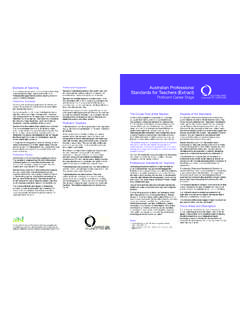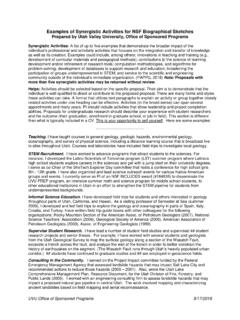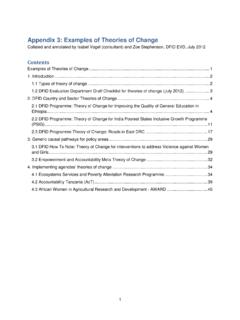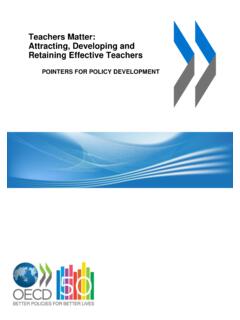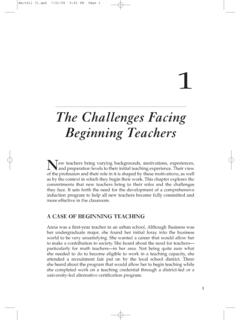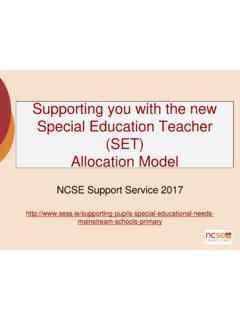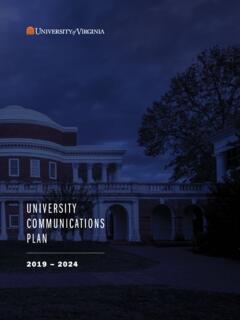Transcription of Australian Professional Standards for Teachers
1 Australian Professional Standards for TeachersThis version of the Australian Professional Standards for Teachers was adopted by the Queensland College of Teachers (QCT) with permission from the Australian Institute for Teaching and School Leadership (AITSL). 2011 Education Services Australia as the legal entity for the Standing Council on School Education and Early Childhood (SCSEEC).Education Services Australia as the legal entity for the Standing Council on School Education and Early Childhood (SCSEEC) owns the copyright in this publication. This publication or any part of it may be used freely only for non-profit education purposes provided the source is clearly acknowledged. The publication may not be sold or used for any other commercial than as permitted above or by the Copyright Act 1968 (Commonwealth), no part of this publication may be reproduced, stored, published, performed, communicated or adapted, regardless of the form or means (electronic, photocopying or otherwise), without the prior written permission of the copyright owner.
2 Address inquiries regarding copyright to:SCSEEC Secretariat, PO Box 202, Carlton South, VIC 3053, of ContentsPreamble 2 Organisation of the Australian Professional Standards 4 Organisation of the Standards 6 Professional KnowledgeSTANDARD 1 8 STANDARD 2 10 Professional PracticeSTANDARD 3 12 STANDARD 4 14 STANDARD 5 16 Professional EngagementSTANDARD 6 18 STANDARD 7 19 Glossary 20 Australian Professional Standards for Teachers 21 Australian Professional Standards for Teachers 12 Australian Professional Standards for TeachersThe Crucial Role of the TeacherTeachers share a significant responsibility in preparing young people to lead successful and productive lives.
3 The Australian Professional Standards for Teachers (the Standards ) reflect and build on national and international evidence that a teacher s effectiveness has a powerful impact on students,i with broad consensus that teacher quality is the single most important in-school factor influencing student effective Teachers can be a source of inspiration and, equally importantly, provide a dependable and consistent influence on young people as they make choices about further education, work and life. As stated in the National Partnership on Improving teacher Qualityiii and the Melbourne Declaration on Educational Goals for Young Australians,iv improving teacher quality is considered an essential reform as part of Australia s efforts to improve student attainment and ensure it has a world class system of education.
4 The greatest resource in Australian schools is our Teachers . They account for the vast majority of expenditure in school education and have the greatest impact on student learning, far outweighing the impact of any other education program or policy .vInternationallyvi and locally, education systems are developing Professional Standards for Teachers as a mechanism to attract, develop, recognise and retain quality Teachers . High performing school systems, though strikingly different in construct and context, [maintain] a strong focus on improving instruction because of its direct impact upon student achievement .viiProfessional Standards for TeachersDeveloping Professional Standards for Teachers that can guide Professional learning, practice and engagement facilitates the improvement of teacher quality and contributes positively to the public standing of the profession.
5 The key elements of quality teaching are described in the Standards . They articulate what Teachers are expected to know and be able to do at four career stages: Graduate, Proficient, Highly Accomplished and Lead. The Standards and their descriptors represent an analysis of effective , contemporary practice by Teachers throughout Australia. Their development included a synthesis of the descriptions of Teachers knowledge, practice and Professional engagement used by teacher accreditation and registration authorities, employers and Professional associations. Each descriptor has been informed by Teachers understanding of what is required at different stages of their careers. An extensive validation process involving almost 6,000 Teachers ensured that each descriptor was shaped by the profession. The Standards support the Melbourne Declaration,viii which describes aspirations for all young Australians for the next decade.
6 This commits Australian Education Ministers to the specific educational goals that Australian schooling promotes equity and excellence and that all young Australians will become successful learners, confident and creative individuals, and active and informed A l l Australian governments, universities, school sectors and individual schools have a responsibility to work together to support high quality teaching and school leadership, including by enhancing preservicex teacher education .xi Preamble The greatest resource in Australian Schools is our Teachers . They account for the vast majority of expenditure in school education and have the greatest impact on student learning, far outweighing the impact of any other education program or policy. vAustralian Professional Standards for Teachers 3 Notes:i.
7 J Hattie, Teachers make a difference: what is the research evidence? paper presented to Australian Council for Educational Research Annual Conference, Melbourne, 19 21 October Organisation for Economic Co-operation and Development (OECD), Teachers mat-ter: attracting , developing and retaining effective Teachers , 6th edn, Paris, OECD Publishing, Council of Australian Governments (COAG), National partnership on improving teacher quality, Canberra, 2008, viewed 31 January 2011iv. Ministerial Council for Education, Employment, Training and Youth Affairs, Melbourne declaration on educational goals for young Australians, Melbourne, 2008, viewed 31 January 2011, B Jensen, What Teachers want: Better teacher management, Melbourne, Grattan Institute, 2010, p. OECD, teacher evaluation: a conceptual framework and examples of country prac-tice , paper presented at the OECD-Mexico workshop, Towards a teacher evaluation framework in Mexico: international practices, criteria and mechanisms, Mexico City, 1-2 December M Barber & M Mourshed, How the world s best-performing school systems come out on top, London, McKinsey & Company, 2007, p.
8 Ministerial Council for Education, Employment, Training and Youth Affairs, Melbourne declaration on educational goals for young Australians, Melbourne, 2008, viewed 24 November 2010, ix. Although Australian education systems perform strongly against other OECD countries, low equity is still a significant issue. In response to this,the Melbourne Declaration commits to specific actions such as improving educational outcomes for Indigenous youth and students with The terminology initial teacher education has replaced the term preservice teacher Ministerial Council for Education, Employment, Training and Youth Affairs, Melbourne declaration on educational goals for young Australians, Melbourne, 2008, viewed 31 January 2011, p. 11. RJ Yinger & MS Hendricks-Lee, The language of Standards and teacher education reform, Educational Policy, 14(1), 2000, 94 106, viewed 18 January 2011, In New South Wales (NSW) accreditation is the equivalent of registration.
9 X v. Accreditation in of the StandardsThe Australian Professional Standards for Teachers is a public statement of what constitutes teacher quality. They define the work of Teachers and make explicit the elements of high quality, effective teaching in 21st century schools that will improve educational outcomes for students. The Standards do this by providing a framework which makes explicit the knowledge, practice and Professional engagement required across Teachers careers. They present a common understanding and language for discourse between Teachers , teacher educators, teacher organisations, Professional associations and the Standards also inform the development of Professional learning goals and provide a framework by which Teachers can judge the success of their learning and inform their self-reflection and Teachers can use the Standards to recognise their current and developing capabilities, Professional aspirations and contribute to the professionalisation of teaching and raise the status of the profession.
10 They could also be used as the basis for a Professional accountability model,xiii helping to ensure that those who are qualified members can demonstrate certain levels of Professional knowledge, Professional practice and Professional Australian Professional Standards for Teachers are organised into four career stages and guide the preparation, support and development of Teachers . The stages reflect the continuum of a teacher s developing Professional expertise from undergraduate preparation through to being an exemplary classroom practitioner and a leader in the Graduate Standards underpin the accreditation of initial teacher education programs. Graduates from accredited programs qualify for registrationxiv in each state and Proficient Standards are used to underpin processes for full registration as a teacher and to support the requirements of nationally consistent teacher Standards at the career stages of Highly Accomplished and Lead will inform voluntary certificationxv through jurisdictional processes underpinned by nationally agreed common principles.

